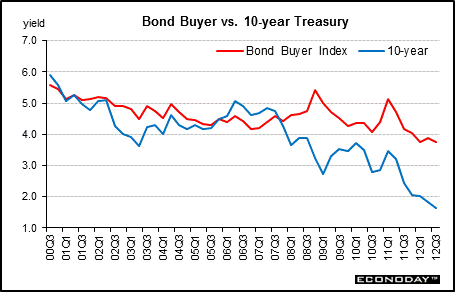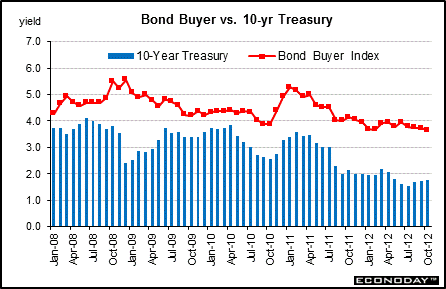 |

Yields on municipal bonds typically are lower than on Treasury notes because the interest earned is exempt from federal income tax. Concern over declining municipal revenues from the recent recession and continued sluggish local economies have pushed muni bond yields up relative to the 10 year T-bond, though the gap narrowed in late 2009 and during early 2010. Flight to safety to Treasuries boosted the gap in 2011 and in 2012.

The 10-year note yield remains well below the Bond Buyer Index – which is unusual. Typically, one expects the bond buyer index to be lower than the Treasury yield since it is comprised of tax-free municipal bonds. But flight to quality has kept the Treasury yield relatively low while concern about the viability of some muni bond insurers has boosted muni yields. The recent recession put many municipalities in fiscal distress which continues. During 2009 and much of 2010 muni yields came down somewhat as rates were seen as very attractive and better economic news somewhat eased worries about default by either municipalities or insurers. But in late 2010 and in early 2011, worries about fiscal distress of states (which provide support to some municipalities) and cities resurfaced and Bond Buyer rates surged. In latter 2011, both rates declined with a sluggish economy a key reason. The Bond Buyer Index still remains dramatically higher than the 10-year Treasury yield due to relatively high concern over municipality revenues and as the T-note rate has been bumped down on flight to safety for various reasons. Bankruptcy filing by Jefferson County, Alabama (inclusive of Birmingham) on November 9, 2011 added to these concerns about the fiscal health of local governments. A few other cities joined the bankruptcy list in 2012 along with some various special local authorities. In October, the Bond Buyer rate dipped 8 basis points to 3.65 percent while the 10-year T-note increased 3 basis points to 1.75 percent.



Production & Sales •
Inflation •
Federal Reserve Policy •
Interest Rates
|
 |